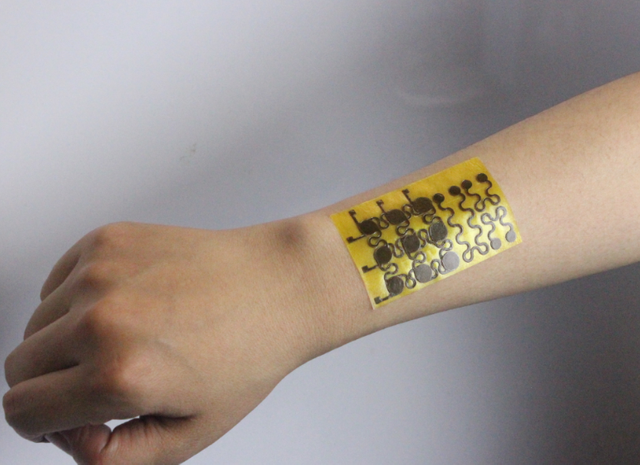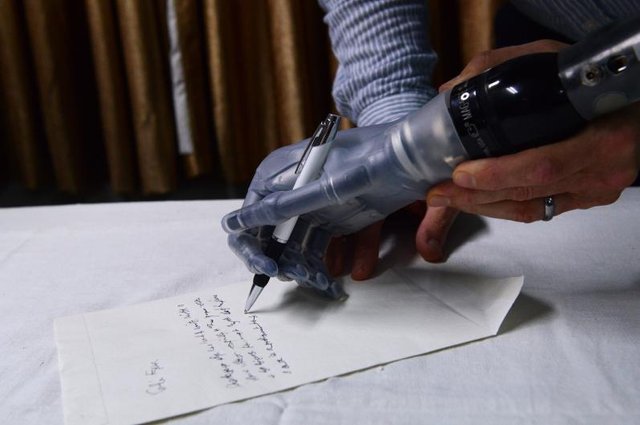SELF-HEALING ELECTRONIC 'SKIN' LETS AMPUTEES SENSE TEMPERATURE AND PRESSURE ON PROSTHETIC LIMBS
Biomedicine just took another jump forward. College of Colorado Boulder researchers made alleged electronic skin—e-skin for short. The e-skin is a thin, semi-straightforward material that can demonstration like your skin through estimating temperature, weight, dampness and wind stream. The new material, which was point by point in an examination distributed Friday in Science Advances, could improve prosthetics, enhance the security of robots later on and help improvement of other biomedical gadgets.
"This has very expansive applications, it might be said, to empower impression of generally inactive frameworks," Jianliang Xiao, mechanical architect at Boulder who drove the investigation, told Newsweek. Those latent frameworks are the electronic gadgets we utilize, yet which don't have similar abilities that our skin normally has.
A segment of the electronic skin created by researchers at the University of Colorado Boulder.

This e-skin can detect for weight, which is a key factor for enhancing prosthetic appendages. For example, if the e-skin is wrapped around a prosthetic hand, the e-skin would empower the prosthetic to detect for weight when holding a glass container. Knowing how much weight the mechanical hand is applying could keep a man utilizing it from inadvertently pulverizing the container, Xiao clarified.
"On the off chance that you consider what genuine skin can do, genuine skin can avoid individuals getting scorched [and] can avert individuals getting hurt," Wei Zhang, a science teacher at Boulder and co-creator of the investigation, told Newsweek. "E-skin can essentially impersonate those [preventative] capacities. In any event that is one major piece of the electronic skin."
A prosthetic hand that can compose is presented at the Government Spine Institute in India, July 18, 2013. The improvement of electronic skin at the University of Colorado Boulder could have suggestions for enhancing prosthetic appendages later on.
SAM PANTHAKY/AFP/GETTY IMAGES
The e-skin likewise has applications for the eventual fate of robots. Later on, should robots deal with babies in some shape, they would have the capacity to feel for weight and temperature.
"Detecting is basic since when individuals interface with robots, we need to ensure that robots don't hurt individuals," Xiao said. Robots later on could be taking care of an infant and, if the robot can feel for weight, the robot could deal with an infant all the more securely. Distinguishing a fever is another advantage.
"At the point when the child is wiped out, the robot can simply utilize a finger to touch the surface," Xiao said. At that point, "it can tell what the temperature of the child is."
The material is produced using a polymer organize called polyimine and also silver nanoparticles, the last which give quality, concoction soundness and electrical conductivity. Specialists clarified that the e-skin can recuperate itself, just by blending mixes found in ethanol with the material. Warmth and weight can permit the e-skin to wrap around bended questions effortlessly, for example, human skin and mind boggling automated hands. Furthermore, the material is recyclable, which is the thing that analysts say influences their e-to skin material remarkable.

"I think we are the principal gathering to show reusing of such multifunctional e-skin," Xiao said. E-skin is reused by dousing the polymers into an answer that corrupts the polymers down and isolates the silver nanoparticles, which sink down to the base of the arrangement. "What drives us to make such gadgets to be recyclable is on account of, these days, we are confronting intense natural contamination because of a huge number of huge amounts of electronic waste," he included.
Zhang made the recyclability idea a stride further. He sees a future where you can basically splash your PDA or your PC in an answer that breaks down the materials down to be reused once more. That would be the "fantasy," he said.